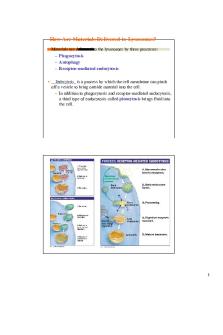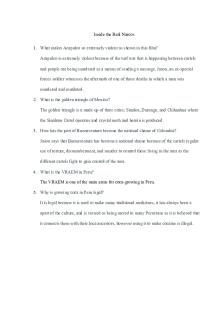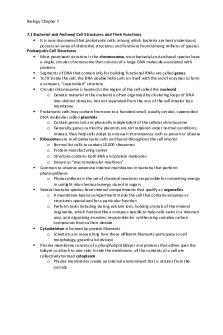Inside the Cells II (3 PDF

| Title | Inside the Cells II (3 |
|---|---|
| Course | General Biology Ii |
| Institution | University at Albany |
| Pages | 19 |
| File Size | 1.4 MB |
| File Type | |
| Total Downloads | 98 |
| Total Views | 153 |
Summary
Download Inside the Cells II (3 PDF
Description
How Are Materials Delivered to Lysosomes? • Materials are delivered to the lysosomes by three processes: – Phagocytosis – Autophagy – Receptor-mediated endocytosis Endocytosis is a process by which the cell membrane can pinch • ___________ off a vesicle to bring outside material into the cell. – In addition to phagocytosis and receptor-mediated endocytosis, a third type of endocytosis called pinocytosis brings fluid into the cell.
1
Endo-Exocytosis
BLAST Animation: Endocytosis and Exocytosis
Receptor-Mediated Endocytosis
2
Receptor-Mediated Endocytosis
Vertebrates
Mosquito
n
Energy Transducing Organelles: Endosymbionts
• FUNCTION: Aerobic_____ ATP production – _____
• FUNCTION: Photosynthesis – _____________
3
Structure and Function at the Whole-Cell Level An organelle’s membrane and its enzymes correlate with its function, and cell structure (e.g., the type, size, and number of organelles) correlates with cell function. •
Cells are dynamic living things with interacting parts and constantly moving molecules.
Cells Organize Their Cytoplasm and Its Contents
c.
4
How Dynamic Are Eukaryotic Cells? • Your body’s cells use, and synthesize, approximately 10 million ATP molecules per second. _______ _______ • Cellular enzymes can catalyze >25,000 reactions per second. • Each membrane phospholipid can travel the breadth of its organelle or cell in under a minute. • The hundreds of trillions of mitochondria inside you are replaced about every 10 days, for as long as you live. • The fluid plasma membrane’s composition is constantly changing.
5
The Signal Hypothesis The signal hypothesis predicts that proteins and other signal ________that sequence macromolecules have a “zip code” or ______ directs the them to a particular location in the cell.
Primary structure
Tertiary structure
The Nuclear Envelope: A Transport Mechanism • The nuclear envelope has two membranes, each consisting of a lipid bilayer, and is continuous with the endoplasmic reticulum. • The inside surface is linked to fibrous proteins that form a latticelamina like sheet called the nuclear ______. – Stiffens the membrane’s structure and maintains its shape – Provides attachment points for each chromosome envelope • The envelope contains thousands of openings called nuclear ____ . – Function as doors into and out of the nucleus
6
How Are Molecules Imported into the Nucleus? • Messenger RNAs and ribosomes are synthesized in the nucleus and exported to the cytoplasm. Materials such as proteins needed in the nucleus are imported into the nucleus. • Movement of proteins and other large molecules into and out of the nucleus is an energy-demanding process. Proteins destined for the nucleus have a molecular “zip code”—a nuclear _______ localization______ signal (NLS)—which 17-amino-acid-long ______ allows them to enter the nucleus. protein always synthecized in the cytoplasm, nowhere else.
7
this protein is not located in the cytoplasm
SV40 NLS: pro-lys-lys-lys-arg-lys-val
SV40 NLS: pro-lys-lys-lys-arg-lys-val
8
The Endomembrane System • The endomembrane system is composed of the smooth and rough ER and the Golgi apparatus, and is the primary system for protein Text and lipid synthesis and membrane _________ and ________. • Ions, ATP, amino acids, and other small molecules diffuse randomly throughout the cell, but the movement of proteins and other large molecules is energy demanding and tightly regulated.
Pulse – Chase Experiments - Cells exposed to a brief “pulse” of radioactive amino acids - Radioactive amino acids washed out and replaced with a non-radioactive “chase” - Cells processed for autoradiography at various times after that
9
secretory _______ pathway hypothesis proposes that proteins intended for • The ______ secretion from the cell are synthesized and processed in a highly prescribed set of steps. • Proteins are packaged into vesicles when they move from the RER to the Golgi apparatus and from the Golgi apparatus to the cell surface. – The RER and Golgi apparatus function as an integrated endomembrane system.
Proteins destined for export have ER-entry signals
E.R. _____ ______
10
The Dynamic Cytoskeleton The cytoskeleton is a complex network of fibers that helps maintain cell shape by providing structural support. The cytoskeleton is dynamic; it changes to alter the cell’s shape, to transport materials in the cell, or to move the cell itself. •
There are three types of cytoskeletal elements: microtubles – ____________ actin filaments (microfilaments) – ______ – Intermediate filaments
Microtubule Structure • Microtubules are large, hollow tubes made of tubulin dimer (twopart compounds) proteins. • Microtubules have polarity, are dynamic, and usually grow at their plus ends. • Microtubules originate from the microtubule organizing center and grow outward, radiating throughout the cell. • Animal cells have just one microtubule organizing center called the centrosome Centrosomes contain two bundles of microtubules called ________. centrioles.
11
centrosomes and centrioles replicate and make half of the mitotic apparatus.
Microtubule Function • Microtubules provide stability and are involved in movement; they may also provide a structural framework for organelles. – Microtubules can act as “railroad tracks”; transport vesicles move through the cell along these microtubule tracks in an energy-dependent process. kinesin and ______ dynein for vesicle • Microtubules require ATP and ______ transport to occur. These are motor proteins that convert chemical energy in ATP into mechanical work.
Organelle movements http://www.youtube.com/watch?v=SyJgz4P-Omo&feature=fvsr
12
Vesicle Transport
BLAST Animation: Vesicle Transport
13
From ER to Golgi • Proteins are transported from the ER to the Golgi apparatus in vesicles that bud off the ER, then fuse with the Golgi apparatus membrane and deposit their contents inside. Each protein that comes out of the Golgi apparatus has a molecular tag that places it in a particular type of transport vesicle. Each type of transport vesicle also has a tag that allows it to be transported to the correct destination.
• Some proteins are sent to the cell surface in vesicles that fuse with the plasma membrane, releasing their contents to the exterior of the cell in a process called __________.
Eukaryotic cells manufacture cytoskeletal protein that help to maintain the cells’ shapes and functions. You would predict these proteins [B] would be manufactured on free ribosomes in the cytoplasm
14
Actin Filaments • Actin filaments are the smallest cytoskeletal elements. proteins • Actin filaments form by polymerization of individual actin ______ molecules.
• Actin filaments are grouped together into long bundles or dense networks that are usually found just inside the plasma membrane and help define the cell’s shape. • Actin filaments can also be involved in movement by interacting myosin . with the motor protein _______ • Actin-myosin interactions can cause cell movements such as cell crawling, cytokinesis, and cytoplasmic streaming.
15
Cytoplasmic Streaming in Plant Cells
Actin and Myosin Produce “Amoeboid Locomotion” moving and building and repairing as it is moving in a cell
16
Intermediate Filaments • Intermediate filaments are defined by size rather than composition. Many types of intermediate filaments exist, each consisting of a different protein. • Intermediate filaments provide structural support for the cell. They are not involved in movement. • Intermediate filaments form a flexible skeleton that helps shape the cell surface and hold the nucleus in place.
Cilia and Flagella: Moving the Entire Cell Eukaryotic flagella
• _______ are long, hairlike projections from the cell surface that move cells. – Bacterial flagella are made of flagellin and rotate like a propeller. – Eukaryotic flagella are made of microtubules and wave back and forth. cilia , which are short, • Closely related to eukaryotic flagella are _____ filament-like projections.
• Cells generally have just one or two flagella but may have many cilia.
17
Cilia and Flagella Structure axoneme of cilia and flagella • The _______ is a complex “9 + 2” arrangemen of microtubules connected by links and spokes.
• The axoneme attaches to the cell at a structure called the basal body.
18
A Motor Protein in the Axoneme dynein • The motor protein ______ forms the arms between doublets and changes shape when ATP is hydrolyzed to “walk” up the microtubule.
• When the dynein arms on just one side of the axoneme move, cilia and flagella bend instead of elongating because the links and bridges constrain movement of the microtubule doublets.
Chapter Summary Taken together, the data reviewed in this chapter can be summed up in six words:
Cells are dynamic, highly integrated structures.
19...
Similar Free PDFs

Inside the Cells II (3
- 19 Pages

Inside THE REAL Narcos
- 1 Pages

Inside Reading 3 Answer
- 21 Pages

Inside The Living Body Notes
- 3 Pages

Inside The Teenage Brain Letter
- 5 Pages

Chapter 7: Inside the Cell
- 10 Pages

Ch 7 - Inside the Cell
- 7 Pages

Chapter 3 Cells and Tissues
- 2 Pages

Cells of the Immune System
- 3 Pages

Chapter 3: Cells - Lecture notes 3
- 13 Pages

Inside job
- 2 Pages

Inside the Criminal Mind quiz 1
- 2 Pages
Popular Institutions
- Tinajero National High School - Annex
- Politeknik Caltex Riau
- Yokohama City University
- SGT University
- University of Al-Qadisiyah
- Divine Word College of Vigan
- Techniek College Rotterdam
- Universidade de Santiago
- Universiti Teknologi MARA Cawangan Johor Kampus Pasir Gudang
- Poltekkes Kemenkes Yogyakarta
- Baguio City National High School
- Colegio san marcos
- preparatoria uno
- Centro de Bachillerato Tecnológico Industrial y de Servicios No. 107
- Dalian Maritime University
- Quang Trung Secondary School
- Colegio Tecnológico en Informática
- Corporación Regional de Educación Superior
- Grupo CEDVA
- Dar Al Uloom University
- Centro de Estudios Preuniversitarios de la Universidad Nacional de Ingeniería
- 上智大学
- Aakash International School, Nuna Majara
- San Felipe Neri Catholic School
- Kang Chiao International School - New Taipei City
- Misamis Occidental National High School
- Institución Educativa Escuela Normal Juan Ladrilleros
- Kolehiyo ng Pantukan
- Batanes State College
- Instituto Continental
- Sekolah Menengah Kejuruan Kesehatan Kaltara (Tarakan)
- Colegio de La Inmaculada Concepcion - Cebu



